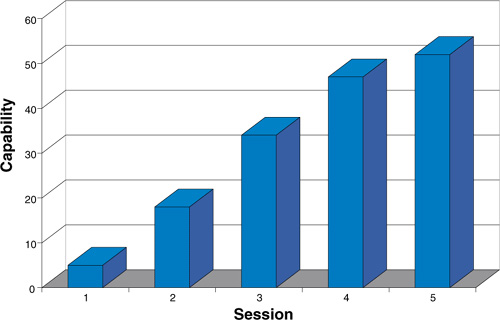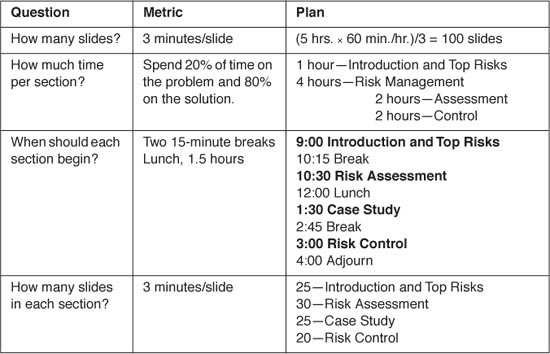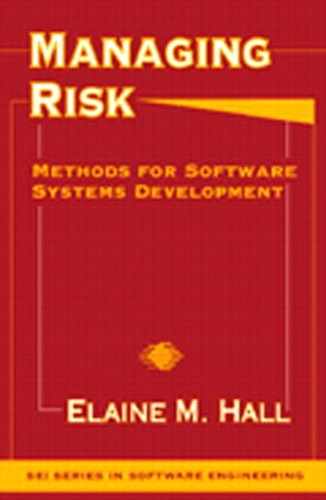11 Train Risk Technology
Talent alone won’t make you a success. Neither will being in the right place at the right time, unless you are ready. The most important question is: “Are you ready?”
—Johnny Carson
Socrates said that you cannot teach anyone anything, you can only make them think. We should remember that people are more likely to retain information on a subject that they perceive as important. Training can help make students more receptive by providing the motivation for learning and help students understand why risk management is important.
Preparation is the key to implementing risk management successfully. I recommend starting at the beginning, with risk management concepts. Understanding the vocabulary of risk management is essential for communication of risk. Just-in-time training is most beneficial. Those who attend training should be able to apply immediately the knowledge learned to increase their skills in managing risk. For example, risk management metrics should not be trained until the project team is serious about following through with quantitative risk management.
In this chapter, I define training metrics that help you provide instruction in risk management. I describe how to increase your organization’s knowledge of risk management technology through the learning process.
This chapter answers the following questions:
![]() What are the steps to train risk management technology?
What are the steps to train risk management technology?
![]() What training modules provide instruction in risk management?
What training modules provide instruction in risk management?
![]() Why do people learn in stages?
Why do people learn in stages?
11.1 Prepare for Training
Preparation is the key to successful training. Preparation includes all the logistics to obtain approval, determine location, and set the date for training. One of the most important steps to get ready for training is to determine the intended audience. To understand your audience, there are three major considerations:
![]() Need. Consider the need of the audience and tailor training illustrations to them. Ask in advance what their requirements are. For example, quality professionals need risk management to prevent problems; system engineers use it to meet technical requirements.
Need. Consider the need of the audience and tailor training illustrations to them. Ask in advance what their requirements are. For example, quality professionals need risk management to prevent problems; system engineers use it to meet technical requirements.
![]() Level. Consider the level of the audience. Executives require more of an overview; practitioners need more details. You need to know who your audience is to adjust the breadth or depth of the training material.
Level. Consider the level of the audience. Executives require more of an overview; practitioners need more details. You need to know who your audience is to adjust the breadth or depth of the training material.
![]() Size. Consider the size of the audience. The training techniques and class exercises you use will vary depending on whether the number of students is 10 or 100.
Size. Consider the size of the audience. The training techniques and class exercises you use will vary depending on whether the number of students is 10 or 100.
11.2 Develop Training Material
Understanding the building blocks of fundamental knowledge in risk management will enable you to adapt to situations as they change and provide you the mental flexibility needed to respond to uncertainty. The following training modules provide risk management instruction:
![]() Session 1: Risk management concepts.
Session 1: Risk management concepts.
![]() Session 2: Risk assessment methods.
Session 2: Risk assessment methods.
![]() Session 3: Risk management process.
Session 3: Risk management process.
![]() Session 4: Risk management measures.
Session 4: Risk management measures.
![]() Session 5: Proactive risk management.
Session 5: Proactive risk management.
The intent of an introduction to risk management is to provide the breadth of knowledge for handling risk situations where there is no textbook answer. A certain amount of general knowledge is required to provide a foundation for reasoning about risk in these predicaments. Training should include the concepts of risk management such as definitions of risk management terminology. The vocabulary of risk management can be learned in a series of progressive steps. The terminology required to be mastered at each of five training sessions is shown in Table 11.1 Training provides the discussion of each of these terms using examples to illustrate the meaning of each. Various exercises should be incorporated into the training material to ensure that each student has a complete grasp of the concepts. Exercises should be performed during training to give students time to try techniques and have their questions answered. Students’ skills in risk management increase from novice to expert as they comprehend the terminology of progressive training sessions. As shown in Figure 11.1 understanding more complex concepts is an investment in increasing risk management capability. Over 50 words are learned in the process of mastering risk management concepts.
Table 11.1 Risk Management Terminology

* Also known as the risk management index.
Figure 11.1 Increasing skills through training. Learning risk management terminology is an investment that builds vocabulary and increases your capability to manage risk. Each training session builds on knowledge learned in the previous session.

Using the Personal Software Process, individuals become competent in four stages of learning [Humphrey95]. Training material should help people through these stages of learning. The trainer should be sensitive to the current learning stage of the target audience. If people understand that the stages of learning are normal and universal, they will be able to articulate the stage they can associate with. Trainers should begin at that stage and progress through the learning stages. There are four stages of individual learning:
1. Unconscious inability. We are unaware of risk concepts and lack a vocabulary to reason about risk. In this stage, we are oblivious to the risks because we do not know how to verbalize them. We may feel frustration in a situation that appears beyond our control.
2. Conscious inability. We become aware of risk concepts but do not have the ability to manage risk. We may feel anxious and worry about risk consequences.
3. Conscious ability. We put risk concepts into practice, which increases our capability to manage risk. We see results in proportion to our persistence in managing risk.
4. Unconscious ability. Our brain can make associations based on new information and past experience. These associations exist in our mind, which can potentially identify and resolve risks even as we sleep.
As we develop training material, we must remember that people learn in different ways. Some people remember best by hearing, some by seeing, and some by doing.
Individual learning preferences require different types of instructional methods. As shown in Table 11.2 there are four categories of instructional techniques that are based on a person’s primary reason for education [Keirsey84]. Be sure to use a variety of instructional techniques to reach your audience.
11.3 Apply Training Metrics
After you have determined the correct order of the training material, allocate time to each topic, bearing in mind that a relaxed pace is conducive to learning. You need to fit the training material to the time constraint, which undoubtedly will require a trade-off between breadth (covering more material at a higher level) and depth (covering less material in more detail). How can you be sure that you have planned the training material appropriately? The training metrics shown in Table11.3 will help you refine your training plan by applying rules of thumb. These guidelines have been proved effective through historical data that I obtained from my one-day risk management training seminars. In this case, “effective” means covering all material on time at a relaxed pace.
Table 11.2 Instructional Techniques

Table 11.3 Training Metrics For A One-Day Plan

11.4 Deliver Training
There are numerous ways to deliver training, such as by cassette tape, video, and direct satellite broadcast. The method that is right for a project depends on the budget and the available technology. Training the old-fashioned way—in person—is preferable for the highest-quality interaction between instructor and student.
Regardless of the training method, the pace of the material should be relaxed to facilitate learning. Around 100 words per minute is a good metric to follow. Although risk management is a serious topic, it is not a somber one. Trainers should incorporate engaging illustrations that help students learn and understand how to moderate humor that opens the mind and makes students receptive to new ideas.
Here are some guidelines for effective communication [Rohn89] in risk management training:
![]() Have something good to say. There is no substitute for preparation and research of the training material. The knowledge of training risk management must come from real-world experience. Otherwise, risk management will seem superficial to the audience, and you will quickly run out of illustrations.
Have something good to say. There is no substitute for preparation and research of the training material. The knowledge of training risk management must come from real-world experience. Otherwise, risk management will seem superficial to the audience, and you will quickly run out of illustrations.
![]() Say it well. Practice the timing of the material so that you make each point with brevity and clarity. Use analogies and stories to illustrate your points.
Say it well. Practice the timing of the material so that you make each point with brevity and clarity. Use analogies and stories to illustrate your points.
![]() Read your audience. Notice the reaction of your audience to what you are saying. Are they nodding in agreement or falling asleep? Make adjustments as necessary.
Read your audience. Notice the reaction of your audience to what you are saying. Are they nodding in agreement or falling asleep? Make adjustments as necessary.
![]() Use words with emotion. Inflection in your voice provides clues to your audience. Stories about risk management can be exciting as well as devastating. Teach your students with your own style. Use emotion to help students make associations that will enable them to remember. Repetition of phrases gives the clue that what you just said is worth remembering.
Use words with emotion. Inflection in your voice provides clues to your audience. Stories about risk management can be exciting as well as devastating. Teach your students with your own style. Use emotion to help students make associations that will enable them to remember. Repetition of phrases gives the clue that what you just said is worth remembering.
![]() Identify with your audience. Begin with the level of your audience. The reaction from the audience should be, “Me too,” not, “So what?”
Identify with your audience. Begin with the level of your audience. The reaction from the audience should be, “Me too,” not, “So what?”
11.5 Obtain Training Feedback
When you begin training, ask the students what they hope to learn. Set appropriate expectations by reviewing this list and explaining what will and will not be covered. Periodically you can review these expectations to be sure that each topic will be covered by the end of the session. At the end of the session, review these expectations with your audience to show that each topic was addressed. Be sure to call for questions at the end of each training segment to encourage participation.1 During a training session, it is important for you to review the checkpoints established in your plan. For example, you should note the actual time for each section. This information can be used to refine the timing of your current presentation, as well as future training sessions.
1 Many European cultures discourage the questioning of a lecturer. To overcome this, I use a slide containing three summary questions at the end of each section to stimulate discussion.
Training evaluations help you improve future training sessions. As an instructor, you should maintain metrics to improve your performance. Use the same fivepoint scale (1 = poor, 2 = fair, 3 = average, 4 = good, 5 = excellent) so that you can measure your progress over time. Be sure to specify the training title, instructor’s name, and date on the evaluation form. A one-page form should be sufficient to gather feedback for improvement. Training evaluations should ask the students to rate and comment on their assessment of training in the following areas:
![]() Value of training content.
Value of training content.
![]() Speaker presentation skills.
Speaker presentation skills.
![]() Training facilities.
Training facilities.
![]() The part of training I liked best.
The part of training I liked best.
![]() The part of training I liked least.
The part of training I liked least.
![]() I still have a need for __________.
I still have a need for __________.
![]() Other comments.
Other comments.
By immediately using feedback from training, you will be better prepared for your next training session. Update the training material to reflect any errors found during the course of training, and develop new material to address the needs that students identified on the training evaluations. Make a mental note to research any questions the students had that you could not answer to their satisfaction. Instructors should maintain an appetite for learning, which will help them keep pace with software risk management technology.
11.6 Summary
In this chapter, I defined the steps to train risk management technology:
1. Prepare for training.
2. Develop training material.
3. Apply training metrics.
4. Deliver training.
5. Obtain training feedback.
I sequenced the training modules that provide risk management instruction:
1. Risk management concepts.
2. Risk assessment methods.
3. Risk management process.
4. Risk management measures.
5. Proactive risk management.
People learn in stages. At first, we are unaware of risk concepts and lack a vocabulary to reason about risk. We progress to the second stage when we become aware of risk concepts. In the third stage, we put risk concepts into practice, which increases our ability to manage risk. In the fourth stage, our brain makes associations based on new information and past experience. These associations exist in our mind, which can potentially identify and resolve risks even as we sleep. The four stages of individual learning are as follows:
1. Unconscious inability.
2. Conscious inability.
4. Unconscious ability.
11.7 Questions for Discussion
1. Do you think risk management is important? Explain your answer.
2. Explain the order of the risk management building blocks. Discuss what each training module provides as a foundation to prepare for the next building block.
3. Describe the five themes for the progressive increments of risk management vocabulary. Which term from each increment best represents this theme? Discuss how each group of terms supports this theme.
4. How can you determine the stage of learning your audience is in with respect to a given risk management training module? What is the likelihood that your students are in different stages of learning? How can you accommodate diverse abilities in a single classroom?
5. Which instructional techniques do you prefer? List the techniques you will use to ensure that all your students will learn.
6. Compare and contrast breadth and depth of training material. Give an example of each in risk management training.
7. Discuss the utility of training metrics. In your opinion, what is a good training metric for a high-quality instructor-to-student ratio?
8. List five ways that you can add emotion to your voice when you speak.
9. Do you think it is important to review students’ expectations at the end of training? Discuss why you do or do not think so.
10. Are you ready to manage risk? If so, how have you prepared to manage risk? If not, what will you need to be prepared?
11.8 References
[Keirsey84] Keirsey D, Bates M. Please Understand Me. DelMar, CA: Prometheus Nemesis, 1984.
[Humphrey95] Humphrey W. A Discipline for Software Engineering. Reading, MA: Addison-Wesley, 1995.
[Rohn89] Rohn J. Take Charge of Your Life. Audiocassette. Chicago: Nightingale-Conant, 1989.
